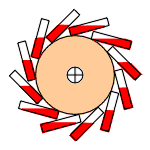2. Prototype -“Indian wheel”
 As a prototype of the developed device can be regarded as so-called "Indian wheel". This is one of the earliest attempts to create a perpetual motion machine, known by the description of the Indian astronomer Lalla (748 CE)[1].
As a prototype of the developed device can be regarded as so-called "Indian wheel". This is one of the earliest attempts to create a perpetual motion machine, known by the description of the Indian astronomer Lalla (748 CE)[1].
The original idea that inspired of this inventor was the desire to provide a "perpetual rotation of the wheel", thanks to the continuous emergence of unequal-arm levers of rotation about a common axis for several pairs loads of equal mass. At this, it was assumed that to ensure "perpetual rotation" would be sufficient use only the energy of the gravitational influence of the earth on the loads.
Since then, up to the present time, some people have been excited by this idea. The main reason for failure of the many attempts to create of the engine on the basis of this idea is contradiction to the fundamental law of nature - "Law of Conservation of Energy".
The very definition of "Perpetual Motion machine" ("Perpetuum Mobile"), which came to us from ancient times, should be regarded as unsuccessful. Anyone, who has ever engaged in the development, manufacture, maintenance or use of devices required in his everyday life, knows that any product of human hands, regardless of the type of energy which ensure his functioning, has a limited lifetime and can not be eternal. Currently is more often used the term "Overunity" (greater than 100% efficiency). This term describes hypothetical machines that operate or produce useful work indefinitely and, more generally, hypothetical machines that produce more work or energy than they consume, whether they might operate indefinitely or not[2]. Such definition sets the task in front of any inventor, who claims that his device is "Overunity", to prove it by means of quantitative measurement and subsequent comparison of energy entering the input device, with the useful energy that is being developed at the output (in the load). At the same time, should also be considered the natural energy losses (friction, heat and so on).
In the last years, can be found on the Internet a lot of descriptions of engines that use sources of pure energy - magnetic, gravity, gravity - magnetic and some others[3],[4],[5]. Very often authors and sometimes commentators naively characterize these devices as "Overunity", despite the fact that the possibility of creating such machines is contrary to modern concepts of physical science. At the same time the authors do not give results of correct measurements, or are not even aware that these measurements should be done. It should also be noted that the measurements themselves are the serious problem. Modern specialists can measure the useful energy which is transmitted directly to the load, but by themselves, these measurements are not nearly simple. Measurements of friction losses and of the heat losses are even more arduous task. With respect to input energy, emanating for example from the magnets, then in general there is no way to make precise measurements because of the extreme complexity of the magnetic fields. It is possible only make very rough estimates. But if the author can not produce evidence, then how can he argue that its product, contrary to the Law of Conservation of Energy, "Overunity" or even "Perpetuum Mobile"? At the same time we have no reason to doubt that some of the proposed motors, where in addition, for example, to the kinetic energy of the gravitational field are also used other sources of energy, really workable, although for such motors are still hard to compete in today's market against devices which operate on combustible and polluting energy sources.
In order to nevertheless find the possibility use of the said useful property of the unequal-arm levers of rotation, without violating the basic laws of nature, has been made thorough calculation in general form the net torque of the device, similar in its mechanical characteristics to the so-called "Indian wheel".This page was last modified on 17 September 2014